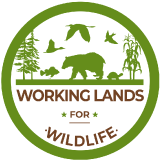-
New Songbird Habitat Study Unlocks Benefits for the Monarch Butterfly
-
by
Web Editor
—
published
Jun 24, 2024
—
filed under:
WLFW,
USDA,
News & Events,
Pollinators,
Golden-Winged Warbler,
News
A new study reveals that managing habitat for songbirds like the golden-winged warbler also benefits insect pollinators like the at-risk monarch butterfly.
Located in
News & Events
-
 Helping People Help the Rivers
Helping People Help the Rivers
-
by
Web Editor
—
published
Jan 22, 2025
—
last modified
Aug 11, 2025 07:50 PM
—
filed under:
WLFW,
USDA,
NRCS,
Aquatics,
Working Lands for Wildlife,
Eastern Hellbender,
virginia tech
Improve farm sustainability and help aquatic wildlife.
Located in
Resources
/
General Resources and Publications
-
 Winter Grazing - a Better Way to Feed
Winter Grazing - a Better Way to Feed
-
by
Admin
—
published
Jun 17, 2021
—
filed under:
Winter Grazing,
USDA,
Grasses,
Webinar,
North Carolina,
Video,
NRCS,
Cattle,
Native Grasslands,
Grazing,
Livestock
In this video, three livestock producers describe how extending the grazing season with winter grasses has saved them time and money, while also improving the environment; and they demonstrate the methods they used to achieve these savings. Sponsored by the NRCS - East National Technology Support Center.
Located in
Training
/
Videos and Webinars
-
 USDA Outreach Notice GS-0482-9/11 Fisheries Biologist
USDA Outreach Notice GS-0482-9/11 Fisheries Biologist
-
by
Web Editor
—
published
Jan 19, 2022
—
filed under:
Job Announcements,
USDA,
Jobs and work
The purpose of the outreach is to notify potential candidates about this upcoming not to exceed one year appointment opportunity.
Located in
Resources
/
Upload New Resources
-
 USDA Natural Resources Conservation Service (NRCS)
USDA Natural Resources Conservation Service (NRCS)
-
by
Web Editor
—
published
Jun 04, 2019
—
last modified
Apr 16, 2024 03:18 PM
—
filed under:
Partners,
American Black Duck,
Farmers,
Federal,
Northern Bobwhite Quail,
Federal Agengies,
Grasslands and Savannas,
Eastern Hellbender,
Resources,
Eastern Deciduous Forests,
Bog Turtle,
American Black Duck Additional Resources,
Golden-Winged Warbler,
Working Lands for Wildlife,
Landowners,
WLFW,
USDA,
New England Cottontail,
Gopher Tortoise,
NRCS,
Aquatics,
Wildland Fire,
Additional Resources,
SE FireMap
NRCS helps America’s farmers, ranchers and forest landowners conserve the nation’s soil, water, air and other natural resources. All programs are voluntary and offer science-based solutions that benefit both the landowner and the environment.
Located in
LP Members
/
Organizations Search
-
 USDA--Farm Service Agency
USDA--Farm Service Agency
-
by
Rosanne Hessmiller
—
last modified
Jun 01, 2022 01:30 AM
—
filed under:
Farmers,
Landowners,
Private Lands,
USDA
Farm Service Agency is equitably serving all farmers, ranchers, and agricultural partners through the delivery of effective, efficient agricultural programs for all Americans.
Located in
LP Members
/
Organizations Search
-
 U.S. Department of Agriculture
U.S. Department of Agriculture
-
by
Rosanne Hessmiller
—
last modified
Jul 16, 2022 03:26 AM
—
filed under:
USDA,
U.S. Department of Agriculture
Our vision is to provide economic opportunity through innovation, helping rural America to thrive; to promote agriculture production that better nourishes Americans while also helping feed others throughout the world; and to preserve our Nation's natural resources through conservation, restored forests, improved watersheds, and healthy private working lands.
Located in
LP Members
/
Organizations Search
-
USDA Agricultural Research Service National Programs
-
by
Tab Manager
—
published
Dec 30, 2020
—
last modified
Mar 25, 2021 11:52 PM
—
filed under:
Agricultural Research Service,
ARS,
Research,
USDA,
Science and Research Products
ARS research is organized into National Programs. These programs serve to bring coordination, communication, and empowerment to approximately 690 research projects carried out by ARS. The National Programs focus on the relevance, impact, and quality of ARS research.
Located in
Resources
/
General Resources Holdings
-
USDA Regional Biomass Research Centers (RBRC)
-
by
Tab Manager
—
published
Dec 30, 2020
—
last modified
Mar 25, 2021 11:53 PM
—
filed under:
ARS,
USDA,
Agricultural Research Service,
RBRC,
Regional Biomass Research Centers,
Science and Research Products,
Research
This USDA-led effort (RBRC), which is coordinated by ARS and the U.S. Forest Service, is tasked with ensuring that dependable feedstock supplies use agricultural and forestry feedstocks to produce advanced biofuels that meet legislated goals and market demand, and maximizing participation of U.S. rural areas in an emerging and profitable biofuels and biobased products economy.
Located in
Resources
/
General Resources Holdings
-
USDA Long-Term Agroecosystem Research Network
-
by
Tab Manager
—
published
Dec 30, 2020
—
last modified
Mar 25, 2021 11:53 PM
—
filed under:
ARS,
USDA,
LATR,
Agricultural Research Service,
Research,
Long-Term Agroecosystem Research Network,
Science and Research Products
The Long-Term Agroecosystem Research (LTAR) Network is a new network developing national strategies for the sustainable intensification of agricultural production.
Located in
Resources
/
General Resources Holdings


